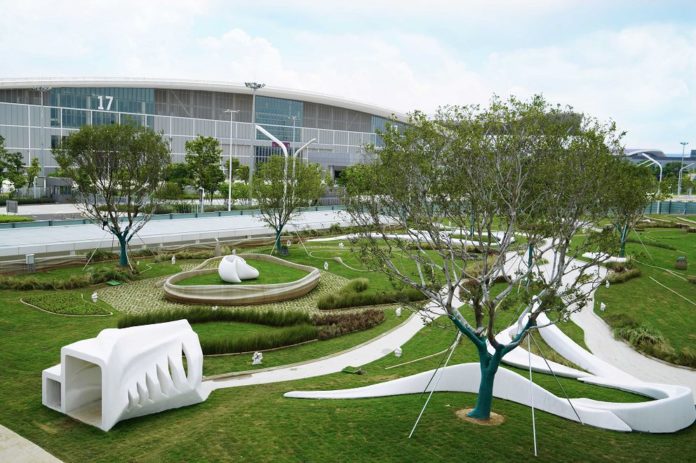The USA is definitely an appealing market for the construction industry. Besides the current implementation of COBOD in the country, the country is host to a range of new comers that have decided to address the housing crisis that handicaps many communities to date.
The latest company that joins the club of this new generation of builders is Advanced Intelligent Construction Technology (AICT). The company develops a robotic-based intelligent construction technology ; a portfolio of technologies that combines advanced robotics, high-performance materials, and parametric design, 3D printing technology.
Like most robotic construction 3D printers work, once the digitally designed model is into the software, the latter processes it into control signals for the robotic arm. The concrete mixture then reaches the nozzle at the front end of the mechanical arm through the extrusion device and is printed rapidly.
AICT’s robotic platform in action
AICT has already used this technology elsewhere to construct significant public works. Recently, the Shenzhen World Exhibition and Convention Center in southern China unveiled a 3D-printed park with a total area of 5,523 square meters (59,449 square feet) with a greening rate of 88 percent. AICT used this 3D printing technology to produce sculptures, benches, flower beds, retaining walls, and curbs. The firm has made a park that is not only state of the art in its construction but is aesthetically pleasing with an attractive, elegant, and futuristic look.
Advantages of such a platform can be seen at the levels of time, cost, sustainability and complex shapes it can deliver.
Indeed, a large percentage of construction costs is rising labor costs due to a shortage of skilled labor. Robotics-based technology empowers the labor force to be more productive, resulting in more efficient job sites, less building time, and overall cost savings. Using 3D printing, AICT can produce a modestly sized house in weeks rather than months. Builders using this technology finished a park consisting of more than 2,000 concrete pieces in just two and a half months, at a fraction of the cost of conventional construction methods.
These reductions in time, personnel, and material costs can reduce overall production costs by as much as thirty percent. Logistical and planning costs are also much lower than with traditional building methods. “Compared with reinforced concrete, 3D printing is relatively cheap, since the building simulation stage will solve technical problems in advance and come up with the optimum construction method,” Xu Weiguo, professor at the Tsinghua University School of Architecture, who led the technical support team..
What’s more, robotic construction technologies like 3D printed concrete provide workers with a safer and healthier working environment because the robot does the repetitive heavy lifting.
As far as sustainability is concerned, 3D printed concrete does not need formwork, usually made from wood and wasted after use. This method prints concrete only in the required places calculated by an algorithm, reducing the usage of carbon-heavy cement. In addition, the sand that makes up almost 50% of the concrete can be sourced locally, saving on transportation costs and carbon emissions associated with transportation.
Last but not least, AICT’s unique printing technology uses a light modular six-axis robotic arm-based system rather than a conventional three-axis, heavy, large-scale gantry system. In addition, the system’s proprietary building material outperforms traditional concrete, producing far more diverse and fluid shapes at no additional cost. This method allows for the creation of attractive and stylish design elements without the expense usually associated with premium designs.
“Intelligent construction is still in its infancy, but the digitization of the construction industry has bright prospects,” said Zhang Yu, an official with the construction bureau of Shenzhen’s Baoan district.
Remember, you can post job opportunities in the AM Industry on 3D ADEPT Media free of charge or look for a job via our job board. Make sure to follow us on our social networks and subscribe to our weekly newsletter : Facebook, Twitter, LinkedIn & Instagram ! If you want to be featured in the next issue of our digital magazine or if you hear a story that needs to be heard, make sure you send it to contact@3dadept.com






